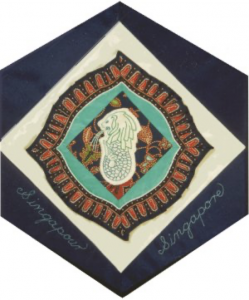Singapore

The Block
Singapore derived its name from ‘Singa Pura’ (Lion City) and its national symbol, the Merlion, is featured at the centre of this block. It is said that when Temasek (ancient Singapore) was being destroyed by a savage storm, a half-fish, half-lion rose from the ocean, calmed the forces of nature and returned to the sea where it now guards the entrance to the Singapore River. The five partings of the Merlion’s mane represent the five ideals of the nation: democracy, peace, progress, justice and equality. Its appearance symbolizes the single-minded resolve of the people to face any challenge and overcome any obstacle.
Batik, a technique of decorating cloth using wax and dye, is a very popular art form in Singapore. Blockmaker Ruth Loh Bauman used a piece of batik fabric, the pattern found on Singapore Airlines uniforms, to frame the square. The material was measured and pleated to create a symmetrical pattern, a reflection of the precise and orderly nature of Singaporeans.
Cultural Profile
Singapore, a small island city-state off the tip of Malaysia, is one of the most densely populated countries on earth. It has the unusual distinction of having several crocodile farms where the reptiles are bred and raised for their skins. Despite its small territory, the country has one of the world’s strongest economies. It is a center for transportation, commerce and finance. Since the country’s independence in 1965, its architecture has moved from traditional Malay timber houses and colonial style buildings to an ever changing cityscape of dazzling modern structures. Parks and protected areas are very important. The country’s four official languages are Chinese Mandarin, English, Malay and Tamil. Ethnic groups are encouraged to continue using their mother tongues as a way of transferring traditions and values for the next generation. Meanwhile a Singaporean identity is slowly emerging through ideals of social harmony and hard work, and participating in the cultural traditions of other cultures, whether in their cuisine or celebrations: Christmas, Eid al-Fitr, Deepavali, Chinese New Year, and Vesak are all public holidays in Singapore.
Singaporeans have a very strong work ethic and also value close family relations. As in other Asian cultures, the people, understanding that their behaviour reflects on their family, work hard not to ‘lose face.’ Community spirit is also important, and activities within each community promote unity and the notion of looking out for one another.
Singapore’s arts and cultural activities are a blend of Chinese, Malay, Indian and Western traditions. Singaporeans are known for their music, traditional dances, including the Chinese Lion Dance and the Bharata Natyam, theatre such as bangsawan (Malay opera), the wayang, Chinese street operas, and the getai street performances. They specialize in the cultivation of orchids, including the Vanda Miss Joaquim, the national flower of Singapore.
Immigration records indicate that Singaporeans have been coming to Canada since 1974, settling mainly in the West and in Ontario. The Malaysia Singapore Kelab in Richmond Hill, Ontario, was formed in 1992 to promote social contact among Malaysians and Singaporeans living in the Greater Toronto Area, and their activities particularly promote Malaysian-Singaporean family values. As of 2011, there were a little over 2,000 Singaporeans living in Canada.
Sponsor: Louise E. Lavictoire
